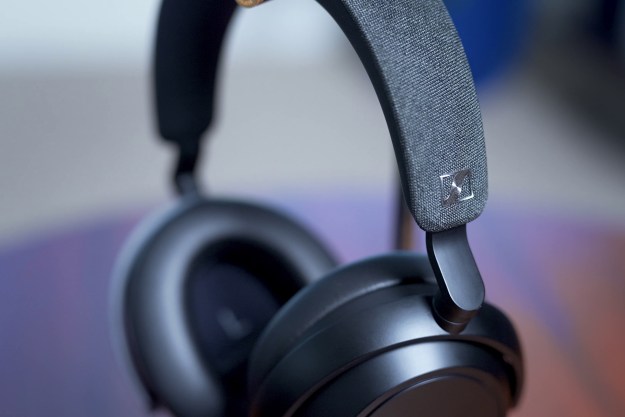“Anyone looking for a good set of sub-$100 headphones should definitely consider the HD435.”
- Strong bass; price; in-line volume control
- Minor low-end distortion at high volumes; significant burn-in time
Summary
When trying to pick a good set of headphones, the common response for anyone seeking advice is, “It’s all subjective. Listen before you buy!” That’s fine if you live in the Gumdrop Kingdom, but back in reality, your options are to either audition a half-dozen overused, half-functional display units or play the “satisfaction guaranteed” exchange game with the few remaining on-line stores that allow simple returns.
In order to maximize the chance that you are getting a set of cans best suited to your listening patterns, you read reviews like this one. We will look at all the most important variables: comfort, build quality, price, general sound quality, unique sound features, and best performing music categories.
It should first be mentioned that the MSRP for the HD435 is only $70, which places this set of headphones at the lower-middle-end of Sennheiser’s offerings. As of publication, it is very difficult to find the HD435 in any brick-and-mortar store, and internet prices tend to hover around $55.
Features and Design
The design of the HD435 seems to imply that they are intended for desktop, non-portable use. There are no collapsing parts, aside from the expanding fit bands by each earpiece, and the earpieces themselves are on the large side. The open air design allows the wearer to hear the outside environment surprisingly well. On the downside, this also means more leakage of sound, annoying those around you.
The ear pads are flat, which seems unusual at first. There is no indentation your ears fit into, and the size is large enough that the pads cover the entire ear. It seems like this might mean they are conducive to slipping off, but we had no such problems. A decorative red ring adorns each earpiece, looking slightly awkward but adding a little color to a peripheral that is generally relegated to a black/gray color scheme.
The three-meter cord plugs into the left earpiece only, and features an in-line volume control. The cord can easily be swapped out or unplugged for easy storage. A 1/4-inch adapter is included as a convenience. The materials are on the cheap side for Sennheiser, but better than most similarly priced options. Don’t expect a metal and real wood enclosure here, though–just be happy the plastic is relatively sturdy.
The general fit of the HD435 is a little loose, owing to the flat-surfaced earpieces. The adjustability is identical to your run-of-the-mill headphones, and the material doesn’t irritate the skin or feel abrasive with prolonged wearing. We had no problems wearing these
Image Courtesy of Sennheiser
Testing and Performance
So, we’re happy with the design, comfort, and price point. What about sound quality? We conducted a general battery of music, movie, and gaming tests using the following:
Sources:
– SoundBlaster Audigy 2 Platinum (for DVD-Audio, CD, and MP3)
– Apple iPod photo (MP3)
– Creative Nano Plus (MP3)
– Sony Playstation portable (MP3)
Music:
– Bjork’s “Vespertine” (DVD-Audio and MP3)
– Mahler Symphony 10 (Berliner Philharmoniker – DVD-Audio)
– The Cure’s “Disintegration” (Audio CD + MP3)
– Gary Numan’s “Exile” (CD and MP3)
– Delerium’s “Karma” (CD and MP3)
– Assemblage 23 – “Storm” (Audio CD and MP3)
– VNV Nation – “Matter and Form” (Audio CD and MP3)
– Louis Armstrong – “All Time Greatest Hits” (Audio CD and MP3)
Movies:
– Spider-Man (DVD)
– The Matrix (DVD)
– Lord of the Rings: Return of the King (DVD)
Games:
– Doom 3 (PC)
– City of Villains (PC)
– Lumines (PSP)
– Wipeout: Pure (PSP)
Before getting to the sound quality tests, it should be noted that we used these headphones for a month straight. The initial sound signature was very different between our first audition and after 2 days of constant burn-in, and again between the post burn-in test and after a month of regular use. The initial sound signature was extremely bass-driven, with very weak mids and a tight sound-stage. Over time, the mids emerged, the bass backed off slightly, and the sound stage opened up significantly.
Music results were very satisfactory. In music tests the sound stage was simply excellent. Sound was not too dispersed or too distant, and the overall spatial acoustic experience was delightful. Bass felt very expansive and omnidirectional and highs were very dynamic, but mids seemed somewhat constrained to the center of the stage. One thing that can be said without question is that the bass is very strong. It doesn’t come across as booming, but smooth and atmospheric (much like many Sennheiser headphones).
Louis Armstrong was particularly fun to listen to, as the mid- to low-end-style music shined for the HD435’s. The Cure and Delerium sounded good, but the high-toned mids seemed to get pushed too far back, and sounded overpowered by the songs’ bass lines. Techno and industrial fared well, which is somewhat counterintuitive. We thought the strange gap in the mid-level sounds might mean vocals from these selections would get lost, but instead they came across very clearly. Was it the age of the recordings? After all, the recording level of music has steadily increased over the past 30 years, due to the perception that louder is better (even though it leaves less bandwidth for actual acoustic quality). But that wouldn’t explain the great performance for Armstrong and Mahler. While listening to Gary Numan, however, it became more clear; it appears that mids–which are softened to provide a more continuous tone (“atmospheric voices”)–fared worse than vocals meant to stand out strongly from the background.
Testing Cont’d
For movie watching, the HD435’s performed well. The strong lows added plenty of atmosphere, and special effects reverberated during action sequences. Dialogue was a little overpowered, especially during scenes with background commotion, but even without 3D sound enhancement, the scene envelopes the listener. For gaming, sound localization was very good, but slightly too dispersed for us to close our eyes and accurately target a sound source. PSP games sounded clear but seemed to lack detail; however, the design of the HD435 does not make them conducive for on-the-go gaming, so this is a forgivable drawback. Doom 3 and City of Villains sounded excellent. More subtle sounds (like jumping and water splashes) were underrepresented, making invisible targets somewhat tough to find.
Conlusion
The Sennheiser HD435 is a great all-around, everyday-use headphone. While the design is not geared toward portable listening, it can be easily driven from most MP3 players and portable gaming devices. Some listeners might find the bass overwhelming, but for gaming, action movies, and high energy music, these cans shine. Music comes across as detailed and strong, but there are some minor peculiarities in the sound signature. Regardless, anyone looking for a good set of sub-$100 headphones should definitely consider the HD435.
Pros:
- Strong bass
- Good Value
- In-line volume control
Cons:
- Minor low-end distortion at high volumes
- Significant burn-in time
Editors' Recommendations
- Best headphone deals: AirPods, Sony, Sennheiser and more
- Sennheiser Accentum Plus aims at the middle ground between budget and baller
- What is 4K? Everything you need to know about 4K Ultra HD
- Sennheiser’s new budget-friendly headphones get a very high-end feature
- Sennheiser’s Ambeo Soundbar Mini is a pricey, bedroom-sized Dolby Atmos speaker





